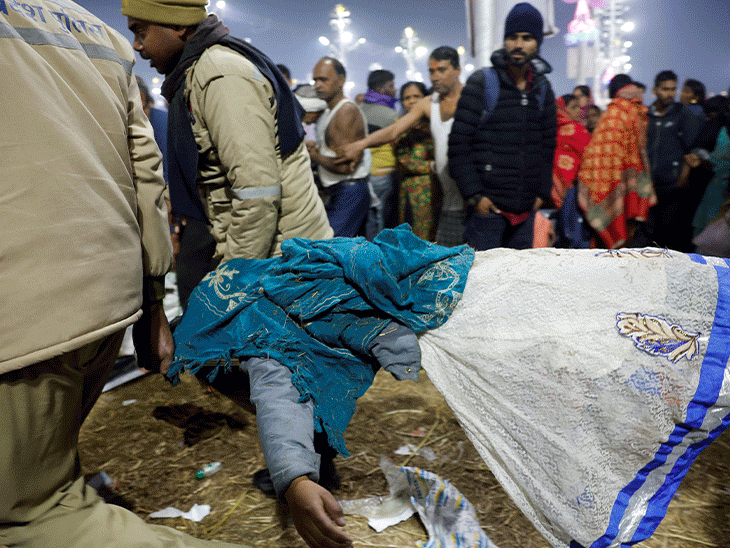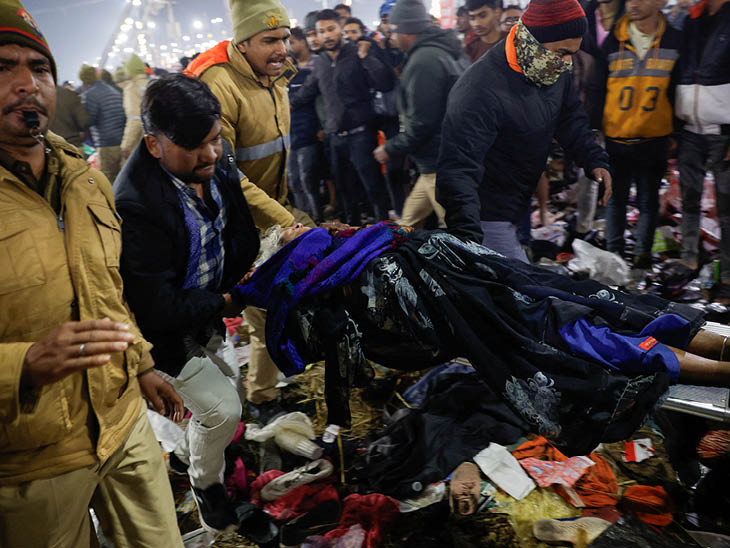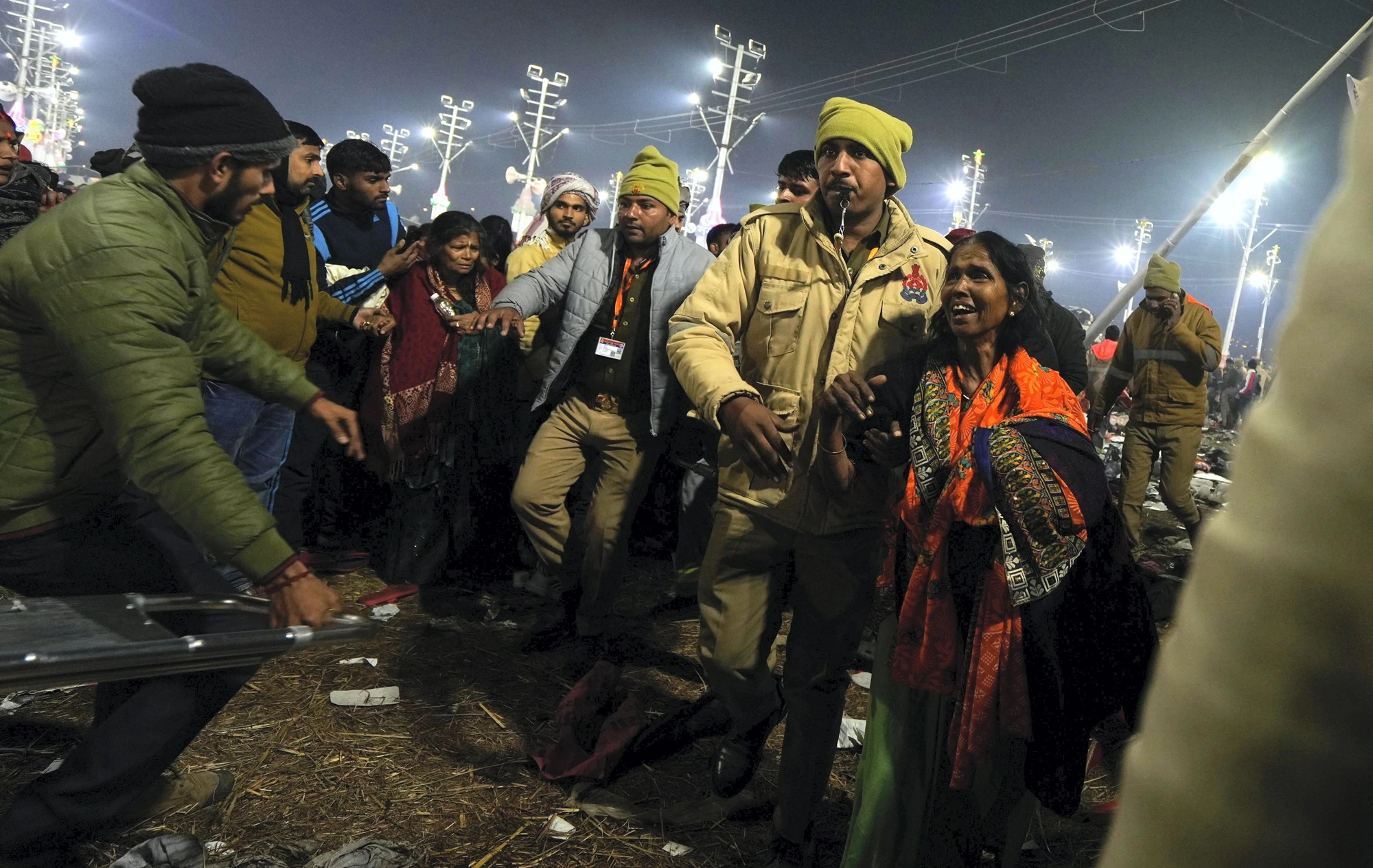
Kumbh Mela Tragic Stampede Kills Over 30
At least 30 people were killed in a deadly stampede at the world’s largest religious festival, the Kumbh Mela, in the northern Indian city of Prayagraj. The tragedy occurred in the early hours of Wednesday when thousands of pilgrims had gathered on the ghats to participate in the sacred ritual of bathing in the holy waters. In the subsequent rush, several pilgrims were trampled to death, causing fatalities and injuries.
At least 60 people were injured in the unrest, officials confirmed, and the official casualty figures were only released after a considerable delay, which was criticized by opposition leaders as a lack of transparency on the government’s part in handling the crisis.
Prime Minister Narendra Modi expressed condolences to the families of those killed and prayed for the speedy recovery of the injured. Meanwhile, numerous pilgrims continued their desperate search for relatives and friends who went missing, adding to the pain and uncertainty of the tragedy.
Senior police officer Vaibhav Krishna addressed the media on Wednesday evening, stating that 90 injured individuals were brought to hospitals, out of which 30 were dead. He continued that 25 of the deceased were recognized. ( दुखद भगदड़ 30 भक्तों की मौत at Kumbh Mela Festival )
Eyewitnesses described the scene as utter chaos, with personal belongings such as clothing, shoes, blankets, and backpacks on the ground. Some pilgrims found it hard to exit because the crowd was pushing from every direction. Ayesha Mishra, one of the witnesses, shared her horror experience with Every Single News (ESN), stating that individuals were being pushed, falling to the ground, and even children were not left out in the scuffle.
Eyewitnesses and visual reports from the site, including videos and photographs, depicted grisly scenes of battered bodies, mud-splattered faces, and injured individuals being carried out on stretchers. Ambulances were seen rushing in and out of the massive tent city erected for the religious event.
There was uncertainty for a number of hours about the exact casualties. Journalists were barred from entering the main hospital, which was cordoned off. Uttar Pradesh Chief Minister Yogi Adityanath acknowledged the critical injuries but did not acknowledge any deaths initially. Even Prime Minister Modi affirmed the sad incident but did not provide the exact number of casualties. In a social media post, he described the situation as “extremely sad” and wished the injured a speedy recovery. ( दुखद भगदड़ 30 भक्तों की मौत at Kumbh Mela Festival )

Despite the tragedy, the massive crowds continued to pour into the festival venue. Government reports indicated that by 2:00 PM local time (08:30 GMT), more than 50 million pilgrims had already taken their holy dip in the river.
The Kumbh Mela, held every 12 years at the sacred confluence of the Ganges (Ganga), Yamuna, and the mythical Saraswati rivers, is one of the most significant events of Hinduism. The pilgrims hold that a bath in the sacred waters will cleanse them of their sins and lead to spiritual liberation. Aside from the religious aspect, the Kumbh Mela is a grand festival of faith that attracts ascetics, politicians, and celebrities alike.
The Chaotic Aftermath of the Tragedy
The festival, which began on January 13 and will continue until February 26, attracts tourists from across India and the world. Pilgrims, including families with young children and elderly relatives, thronged Prayagraj by trains, buses, and taxis to participate in the festival.
Wednesday was the largest bathing day of the festival, and authorities had expected a crowd of nearly 100 million. It was also the day of the Shahi Snan, or royal bath, when thousands of ash-smeared ascetics take their ritual dip in the river. By Tuesday evening, the atmosphere was carnival-like, with massive, colorful processions, frenzied singing, and dancing. But the celebrations soon turned to horror as the stampede took place.
The first reports of the disaster arrived between 01:00 and 02:00 local time (19:30-20:30 GMT) when a number of ambulances were seen rushing to and from the area. At the Sangam Nose, the precise meeting point of the three rivers, a number of pilgrims had been resting close to the barricades when a huge rush of people resulted in the deadly crush, witnesses told Every Single News (ESN). Chaos and panic ensued as tourists attempted to flee, causing injuries and loss of valuables. Poonam Singh, a pilgrim who had traveled with seven members of her family, described her terrifying ordeal, stating that all of them fell in the stampede and were now missing. “I lost all my money, my belongings, and worst of all, I can’t find my family anywhere,” she lamented.
Uncertainty about the precise character of the calamity only made things worse. Some pilgrims suspected something was amiss but continued, unaware of the magnitude of the accident since there was no official word from the authorities. It took until around 04:00 AM for the authorities to make announcements asking people to avoid the Sangam Nose and take their dip at other riverbanks. However, by that time, the paths to the Sangam were already filled with the massive influx of pilgrims. Even hours after the tragedy, tens of thousands of pilgrims walked on in their pilgrimage, undeterred by the gruesome events. Ascetics had briefly considered calling off their ceremonial procession but eventually reached the Sangam with smaller processions. ( दुखद भगदड़ 30 भक्तों की मौत at Kumbh Mela Festival )
For others, the agonizing hunt for missing relatives went on all day and well into the night. The accident scene was still littered with scattered personal effects of victims, like slippers and torn clothes.
There were sorrowful wails of individuals searching for kin at the venue. Anita Devi of Jhansi wandered for hours searching for her husband, who was separated from her during the fracas.
“He needs his medicines, and I have them here with me. In the stampede, I lost hold of his hand, and he was gone in a split second,” she told Every Single News (ESN) desperately. “It’s been so many hours, and I am not able to locate him. There are so many lost-and-found centers here that I don’t even know where to start. I just hope he is alive and safe.”
Government Criticism and Safety Concerns
Fatal stampedes are not uncommon in India due to overcrowding at religious festivals and public gatherings. In a similar incident last year, over 120 people were killed in Hathras district of Uttar Pradesh during a religious festival.
Officials now claim to have the situation at the Kumbh Mela under control. Opposition leaders have, however, descended hard on the government, blaming poor management for the tragedy. Rahul Gandhi, a prominent opposition leader, claimed the authorities were more interested in managing VIP movements than in keeping ordinary devotees safe. In a social media message, he criticized the government’s handling of the tragedy as “extremely sad.” ( दुखद भगदड़ 30 भक्तों की मौत at Kumbh Mela Festival )
Some pilgrims also expressed their wrath at the authorities. Ayesha Mishra questioned the absence of police personnel in the part of the stadium where the stampede took place. “The police were at the other side of the festival grounds, and the crowd was being crushed in the middle,” she said. “This is not how we want to take a holy dip. At this point, the government should ask people to stay home rather than allowing such mismanagement.”

Conclusion
The tragic crowd crush at the Kumbh Mela in Prayagraj underscores the dangers of overcrowding at large religious gatherings in India. With at least 30 lives lost and many more injured, the incident has cast a shadow over what is meant to be a sacred and joyous occasion. The festival, which attracts millions of devotees seeking spiritual cleansing in the holy rivers, quickly turned into a scene of chaos and grief when an uncontrollable rush led to people being trampled. The aftermath saw desperate searches for missing relatives, heartbreaking accounts of families being separated, and criticism directed at authorities for their handling of the situation.
While officials eventually restored order, opposition leaders and eyewitnesses have raised concerns over mismanagement and inadequate crowd control measures. The confusion over casualty figures and restricted access to hospitals only fueled public frustration, with many questioning the government’s preparedness for such a massive event. Despite the tragedy, millions of devotees continued to flock to the venue, reflecting the deep-rooted religious significance of the Kumbh Mela. ( दुखद भगदड़ 30 भक्तों की मौत at Kumbh Mela Festival )
This incident is a grim reminder of past stampedes at religious gatherings in India, where inadequate infrastructure and lack of crowd regulation have led to loss of life. The government must now reassess its approach to managing such events, ensuring that safety measures, crowd control, and emergency response protocols are strengthened to prevent future disasters. Improved planning, better communication, and increased security presence in critical areas could help avoid similar tragedies.
As the festival continues, many families remain in search of their missing loved ones, clinging to hope amid the devastation. The incident serves as a wake-up call for authorities to prioritize public safety over logistical and VIP arrangements, ensuring that devotion does not come at the cost of human lives. ( दुखद भगदड़ 30 भक्तों की मौत at Kumbh Mela Festival )
“Authorities must act now to strengthen crowd safety measures, ensuring that faith and tradition never come at the cost of human lives again.”

